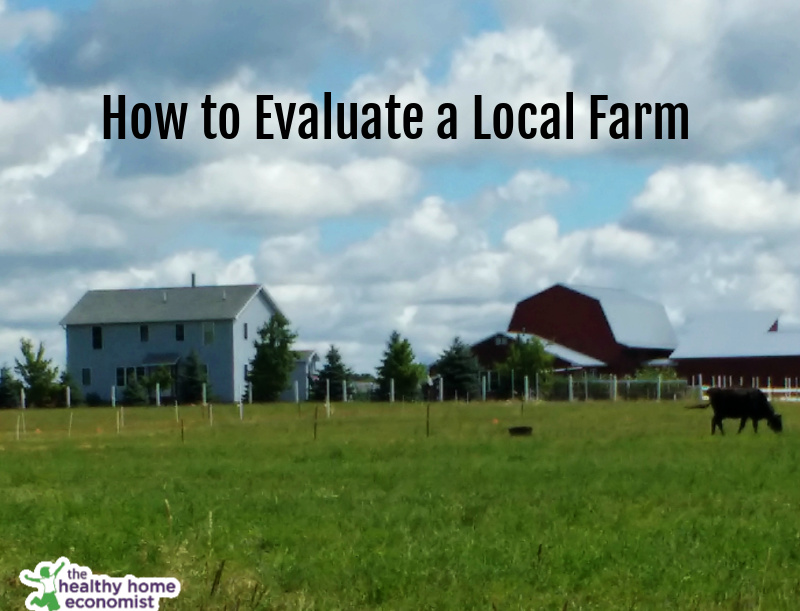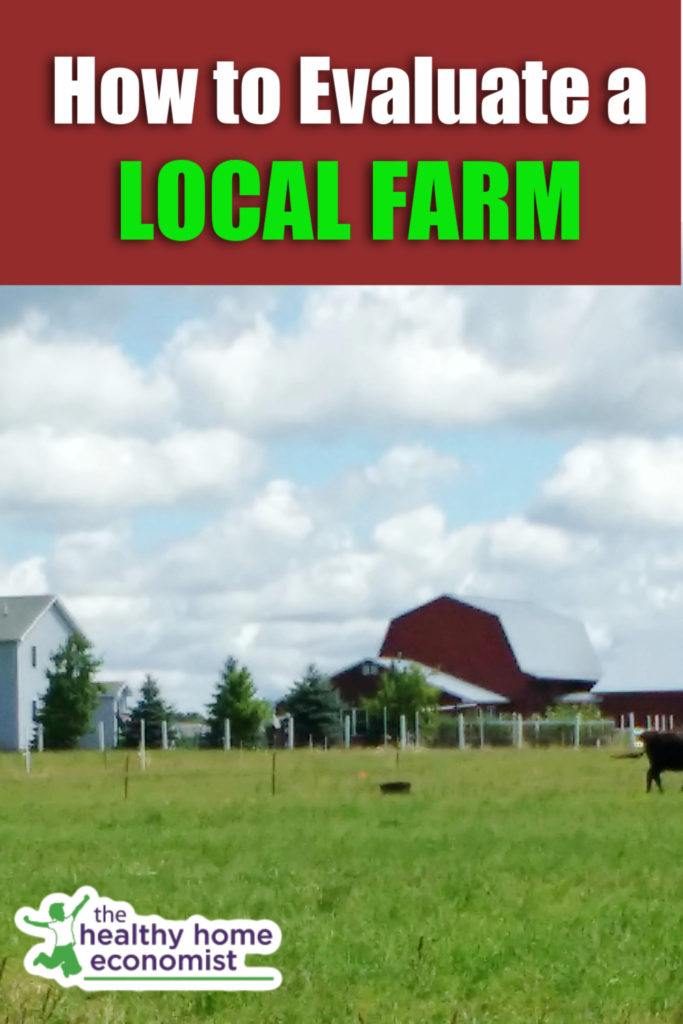Table of Contents[Hide][Show]
How to evaluate a local farm for quality based on the appearance of the animals, quality of the pasture, and the barn and milk house as well as testing that should be regularly performed.
People new to buying grass-fed dairy typically have no idea how to evaluate whether a farm is a good place to spend their local food dollars. Beware – not all grass-based farms are created equal! There are definite signs to look for that will tell you whether or not the farm is well maintained and the animals healthy and capable of producing nutrient-dense dairy for your family.
The following list is based on a lecture I attended at a Wise Traditions Conference. The talk was given by Tim Wightman, Grassfed Dairy Consultant and author of the Raw Milk Production Handbook. Tim has been a farmer for several decades and a dairyman for over twenty years.
Cows
Cows should have a comfortable place to lay down. The herd should look relaxed when laying down, with cows that look half-asleep, possibly with their heads tucked to the side or chewing their cud contentedly. Cows that are forced to lay down in mud or on concrete indicate a poor quality dairy situation.
The herd should be busy grazing and visibly content.
Cows should have good color definition. Brown is brown and white is white. The color stays in the lines and different colors on the cow should not blend together. “Happy lines” on the cows are a good indicator of herd health.
Hair standing up at the back and around the backbone can indicate cows that are not producing particularly nutrient-dense milk.
Cows should be shiny! In winter, the thicker coat reduces this shine somewhat, but cows that don’t shine are not healthy.
Calves should look like adult cows, only smaller. Their backs should be flat.
Cows look at you with their ears. When a cow looks in your direction, the ears should stand up and move in your direction.
Pasture
The pasture where the cows are grazing should have grass that goes over their hooves. Pasture that does not reach that high indicates an overgrazed situation.
The grass in the pasture should be lush. A weedy pasture with visible dirt patches is not a good sign.
Bales of hay in a lush pasture are not only beautiful but also an indicator of a watchful farmer. Too much lush grass can give cows too much protein. Hence, some hay is sometimes needed to reduce the protein in the diet.
Chickens and Other Birds
Diversity in chicken species is not a good sign unless there is plenty of space to roam.
If there is mixing of chicken species, look for missing tail feathers. This indicates too little space for laying hens to free-range.
Do not be concerned if meat birds lay down. This is what they do. Laying hens run around but meat birds do not.
Chickens running around where cow feed or hay is located is not a good sign. Chickens in the pasture are fine, but NOT in the feeding area as cows that eat chicken droppings can harbor salmonella.
Lots of starlings or pigeons in a barn or on wires near a silo is a bad sign. Birds near any sort of feed are a risk of contamination from their droppings.
Look for how many birds are nesting around the cows. It should not be many!
Bird nests over where the cows eat are a problem due to bird dropping contamination.
Contented Cats
Look for cats around the property. Cats are a very good indicator of how well the farm is managed.
Cats should be content, healthy-looking, and easy to pet. Sneezing cats with gunky eyes or a bad coat is a bad sign for the farm in general.
Cats keep scavenger birds down to a minimum on a farm, so fat and sassy cats are a good sign.
Barn and Milk House
The barn should smell like beechnut chewing tobacco.
The barn should NOT smell like ammonia, vinegar, or salami.
The milk house should have clear or black hoses. Orange stained hoses or cracked black hoses are not a good sign. Hoses should be replaced once a year.
The glass in the milking house should be crystal clear.
The window sills should be clean with no dust.
No pitting should be visible on the floor.
Off-colored PVC vacuum lines or stainless steel milk lines (with dust) are not a good sign of cleanliness and attention to detail.
Dairy Testing
Ask what testing the farmer does on his milk. No farm is perfect, but the following tests done once per month are inexpensive and very telling. While a very good tool for the farmer to judge the quality of his cows’ milk, note that they are not mandatory.
- Bulk tank cultures – identifies mastitis in the herd and its prevalence
- Pathogen test results (should be zero)
- MUN Test (Milk Urea Nitrogen) – should be 12-13
If the farmer says he doesn’t test because he doesn’t feed any grain and because he never had a problem, this is not a good enough answer. No farm or farmer is perfect.
A MUN that is too high – 23 or so – would mean that the milk won’t clabber, doesn’t ferment into yogurt or kefir, and the cream won’t whip. High MUN milk is also a little tangy and bitter tasting.
Clearly, there is more to grass-based farming than simply cows grazing on grass. Cows are sensitive creatures and biology is not a switch that can be turned on and off. Farmers transitioning to grass-based farming should be given time to do so and not be asked to quickly flip a biological switch (grain to grass) that is not possible and ultimately unsustainable.
An educated customer is the best consumer!
**The photo above is of the gorgeous Lapp Family Farm in Western New York!









Great tips! I shared the post on my Facebook site.
I’m going to use these to evaluate a local dairy that offers tours to the public – Kreider in Lancaster County.
Sarah,
I wonder if you can help me? I am going to order some grass fed beef. The farmer I spoke to says the cows are grass fed until about 30 days before slaughter and then they are given hay and barley. I understand that barley is classified as a grass but some believe it is grain. Do you have any knowledge to share on this topic?
Thanks,
Greg.
Hi Greg, most beef is finished on grain to fatten them up and marble the beef before slaughter. Store beef is frequently labeled “grassfed” but is GMO grain fed for 3-4 months before slaughter. This eliminates much of the nutrition from the beef.
30 days of grain feeding is not as bad but still not idea. I would shoot for no more than 2-3 weeks of nonGMO grain feeding before slaughter. Beef that is finished on grass tends to be too tough to eat in my experience unless you cook in a crockpot.
If you are seeking tender steaks for grilling, you will need to have the cow finished on non GMO grain for at least a couple of weeks but no more so you don’t lose the nutritional value of the cow’s time spent on grass.
Thanks very much for the info! Upon further communication with the farmer, I learned that the barley is harvested during the green stage and baled like grass for the cows and they are not fed the dry barley grain. Maybe that’s a little better.
This is great information Sarah.
Thanks Sarah for this informative post!
I believe you said before that you have visited the FL farm where you get your dairy for the local co-op. Do they pass on all the points in this list?
I heard that presentation at the 2010 Chapter Leader meeting, too. You took GREAT notes! Thank you for writing this all out. I’m going to share it with many. Also, at our little, family farm, we just milk by hand “Miss Emily”, a six-year-old Jersey. We keep things as clean as possible and have never had any problems, and our yogurt, kefir, and cheesemaking go fine, too. But we are not able to grow four-season grasses perfectly (so we supplement with enough grain to keep her happily coming to the barn morn and night and with hay in the winter), and we often milk outside, which is full of fresh air.
I would also look for actual dairy cattle. Typically, would expect to see Jersey and/or Guernsey for a dairy operation. Holsteins need not apply (for neither dairy nor fat beef).
Anyone know what the norm is for periodic milking at a grassfed farm? daily, 2x daily?
Good, informative post. Might be helpful to consider additional postings for beef and poultry.
Ciao,
Pavil
I would personally like to see cows and calves. So therefore the cows would be milked once per day. That way it allows the calf to remain on the cow. The farmer would lock up the calf each night, milk the cow in the morning and then the calves would be allowed to go with their mums all day. This is good for the calf, good for the farmer and good for the environment. I don’t think many dairy’s do this, but it would work well.
Nothing is more important than taking control of your own health and food sources. Great article!
Just as a heads-up, Tim isn’t the President of Farm to Consumer; Pete Kennedy is. We just interviewed him on Sweet Peas Podcast (www.sweetpeaspodcast.com) Monday!
Lisa Marie
I believe Tim Wightman is president of the Farm-to-Consumer Foundation ), while Pete Kennedy is president of the Farm-to-Consumer Legal Defense Fund, two sister organizations.
Pete is the President of the Farm to Consumer Legal Defense Fund and Tim is the President of the Farm to Consumer Foundation.
Thanks so much for this post. We are very limited in our area, and have relied on people we trust in regards to the farmer we use for our milk. We’ll get to see the farm first hand this June, so it’ll be nice to have a list of what to look for while we’re there!
There is just so much to figure out when you are switching to traditional foods it can be overwhelming!
Thanks, Sarah. One of the hardest things to do when you first start is to know whether your farmers are worth the premium and effort or not. This is a great list.